Iron, IIG
compositionally linked to group IIAB
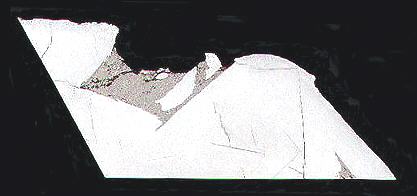
Found 2000
25° 06′ S., 69° 32′ W. A single iron mass weighing 13.1 kg was found by a geologist in El Guanaco, near Aguas Verde, in the Atacama Desert of Chile. The Guanaco mass was submitted for analysis to UCLA (J. Wasson), and elemental ratios were compared to those of the similar schreibersite-rich iron meteoriteIron meteorites consist mostly of metallic iron alloyed with typically between ~5 to ~30 wt% nickel. The main metal phases are kamacite α-(Fe, Ni) and taenite y-(Fe, Ni). Based on their group classification, they may also contain a small weight percentage of one or more of the following minerals: • Click on Term to Read More, La Primitiva, which was also found in the Atacama Desert in Chile. The two iron meteorites exhibit significant differences, notably, in the ratios of As, AuThe astronomical unit for length is described as the "mean" distance (average of aphelion and perihelion distances) between the Earth and the Sun. Though most references state the value for 1 AU to be approximately 150 million kilometers, the currently accepted precise value for the AU is 149,597,870.66 km. The Click on Term to Read More, and Ir, and it was determined that they represent separate falls. Minor fusion crustMelted exterior of a meteorite that forms when it passes through Earth’s atmosphere. Friction with the air will raise a meteorite’s surface temperature upwards of 4800 K (8180 °F) and will melt (ablate) the surface minerals and flow backwards over the surface as shown in the Lafayette meteorite photograph below. Click on Term to Read More was reportedly found on the exposed surface of the Guanaco mass, attesting to a relatively recent fallMeteorite seen to fall. Such meteorites are usually collected soon after falling and are not affected by terrestrial weathering (Weathering = 0). Beginning in 2014 (date needs confirmation), the NomComm adopted the use of the terms "probable fall" and "confirmed fall" to provide better insight into the meteorite's history. If Click on Term to Read More.
Members of this iron group are the most phosphorus-rich meteorites known, with abundant low-Ni
schreibersiteNi-Fe phosphide mineral, (Fe,Ni)3P, yellowish in color and predominantly found in iron and stony-iron meteorites. Schreibersite can also be found in a variety of other meteorites including some acapulcoites, aubrites, enstatite chondrites and achondrites, lunars, ureilites, winonaites and a smattering of other meteorite types like CM, CO and CB. Schreibersite Click on Term to Read More ribbons present throughout. The high P content is consistent with late
crystallizationPhysical or chemical process or action that results in the formation of regularly-shaped, -sized, and -patterned solid forms known as crystals. Click on Term to Read More of dense, P-rich
magmaMolten silicate (rock) beneath the surface of a planetary body or moon. When it reaches the surface, magma is called lava. Click on Term to Read More pockets following large degrees of
fractional crystallizationA crystallization process in which minerals crystallizing from a magma are isolated from contact with the liquid. It is a key process in the formation of igneous rocks during the process of magmatic differentiation. Also known as crystal fractionation. Click on Term to Read More (>80%). Group IIG members are chemically most similar to those of the IIAB iron group, forming extensions to IIAB trends on element–Au diagrams. It has been proposed by Wasson and Choe (2009) that formation of IIG irons occurred inside isolated cavities which remained after crystallization of an evolved IIAB magma. The IIG irons eventually crystallized in a P-rich region of the lower layer of the IIAB
coreIn the context of planetary formation, the core is the central region of a large differentiated asteroid, planet or moon and made up of denser materials than the surrounding mantle and crust. For example, the cores of the Earth, the terrestrial planets and differentiated asteroids are rich in metallic iron-nickel. Click on Term to Read More, while an
immiscibleThe property of liquids that are mutually insoluble (won't mix together) such as oil and water or metallic and silicate melts. Click on Term to Read More and buoyant S-rich magma collected at the upper regions of the magma chamber. Elements such as Au and Ge were likely removed in the S-rich melt phase, while the low-Ni content of IIG irons is attributed to
diffusionMovement of particles from higher chemical potential to lower chemical potential (chemical potential can in most cases of diffusion be represented by a change in concentration). Diffusion, the spontaneous spreading of matter (particles), heat, or momentum, is one type of transport phenomena. Because diffusion is thermally activated, coefficients for diffusion Click on Term to Read More and redistibution of Ni out of
metalElement that readily forms cations and has metallic bonds; sometimes said to be similar to a cation in a cloud of electrons. The metals are one of the three groups of elements as distinguished by their ionization and bonding properties, along with the metalloids and nonmetals. A diagonal line drawn Click on Term to Read More and into schreibersite during an extended cooling history. The Ge-isotopic data were obtained by Luais
et al. (2014), and they found it to be almost identical for both IIG and IIB metal, while a Ge content of 1.3
ppmParts per million (106). Click on Term to Read More and a δ74Ge of –3.4‰ was ascertained for schreibersite in Tombigbee River. Their Ge data support the formation history proposed by Wasson and Choe (2009).
Guanaco is the fifth member of the compositional grouplet that comprises the iron meteorites formerly known as the Bellsbank Quartet—Bellsbank, La Primitiva, Tombigbee River, and Twannberg (see photos below). Therefore, Guanaco provides the requisite number of members needed to establish a new iron chemical group—
The Bellsbank Quintet. John T. Wasson has proposed that this new iron group be designated IIG, its members representing the most Ni-poor, P-rich meteorites of all iron groups. Guanaco has a Ni content of 4.79%, while that of other members of the group ranges from a low of 4.3% (Tombigbee River), to 4.5% (Bellsbank), to a high of 5.1% (La Primitiva, Twannberg).
It is noteworthy that a sample of an iron
meteoriteWork in progress. A solid natural object reaching a planet’s surface from interplanetary space. Solid portion of a meteoroid that survives its fall to Earth, or some other body. Meteorites are classified as stony meteorites, iron meteorites, and stony-iron meteorites. These groups are further divided according to their mineralogy and Click on Term to Read More from China, named Wu-Chu-Mu-Ch’in, which has a heterogeneous chemical composition and structure, includes a portion with trace elements that plot within the Bellsbank IIG group (Bartoschewitz, 2003). This iron portion also has the lowest Ni content (3.5%) of any known iron meteorite. In addition, several pairings of Twannberg have been recovered in recent years, including a 2.246 kg mass which was discovered in January 2000 by M. Jost in the attic of an old house in the village of Twann, and a third mass weighing 2.533 kg discovered in 2005 as part of a rock collection in the Natural History Museum Bern. Besides these two large masses, three smaller fragments were found in 2007 in the Twannbach canyon by M. Wälti and D. Ducrest, bringing the TKW of Twannberg to ~20.771 kg. All six of the Twannberg masses are associated with glacial
tillAn unconsolidated, poorly sorted sediment deposited by glaciers. Till contains rock and mineral fragments of all sizes from clay-size particles to massive boulders. transported by the Rhône glacier during the last ice age (Hofmann
et al., 2009).
Most specimens in this group have a hexahedrite-like
matrixFine grained primary and silicate-rich material in chondrites that surrounds chondrules, refractory inclusions (like CAIs), breccia clasts and other constituents. Click on Term to Read More consisting predominately of
kamaciteMore common than taenite, both taenite and kamacite are Ni-Fe alloys found in iron meteorites. Kamacite, α-(Fe,Ni), contains 4-7.5 wt% Ni, and forms large body-centered cubic crystals that appear like broad bands or beam-like structures on the etched surface of a meteorite; its name is derived from the Greek word Click on Term to Read More, but one Tombigbee River mass, which is lower in P and higher in Ni, shows a small area with a remnant coarse Thomson (Widmanstätten) structure. It was proposed by Vagn F. Buchwald that these irons be structurally classified as
hexahedriteOne of the main types of iron meteorites composed almost entirely of kamacite and named for its cubic (hexahedral) cleavage of α-Fe-Ni crystals. Upon etching, hexahedrites do not display a Widmanstätten pattern, but do often exhibit fine, parallel lines called Neumann lines for their discoverer, Franz Neumann, who first studied Click on Term to Read More, transitional to coarsest
octahedriteMost Common type of iron meteorite, composed mainly of taenite and kamacite and named for the octahedral (eight-sided) shape of the kamacite crystals. When sliced, polished and etched with an acid such as nitric acid, they display a characteristic Widmanstätten pattern. Spaces between larger kamacite and taenite plates are often Click on Term to Read More (H–Ogg). The Guanaco mass has been terrestrially weathered, but remnant
fusionProcess in which two lighter atomic nuclei combine to form a heavier atomic nucleus. Very high temperatures are normally required in order for atomic nuclei to collide with sufficient energy to overcome the Coulomb barrier (their mutual electrostatic repulsions). Fusion that occurs under high-temperature conditions is called thermonuclear fusion. Fusion Click on Term to Read More crustOutermost layer of a differentiated planet, asteroid or moon, usually consisting of silicate rock and extending no more than 10s of km from the surface. The term is also applied to icy bodies, in which case it is composed of ices, frozen gases, and accumulated meteoritic material. On Earth, the Click on Term to Read More and heat-affected zones still remain. Neumann bands record shock forces, including the violent entry into Earth’s atmosphere.
The 27 g partial slice of Guanaco shown above exhibits schreibersite ribbons and patches, while the top photo below shows the regmaglypted
main massLargest fragment of a meteorite, typically at the time of recovery. Meteorites are commonly cut, sliced or sometimes broken thus reducing the size of the main mass and the resulting largest specimen is called the "largest known mass". Click on Term to Read More as found. The middle photos below show the complete Twannberg stone and an interior view of the main mass, with its similarity to Guanaco; compare also to the bottom photo, a rare slice of La Primitiva.
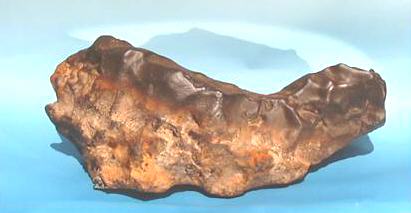
Guanaco—photo courtesy of Atacama Desert Meteorites
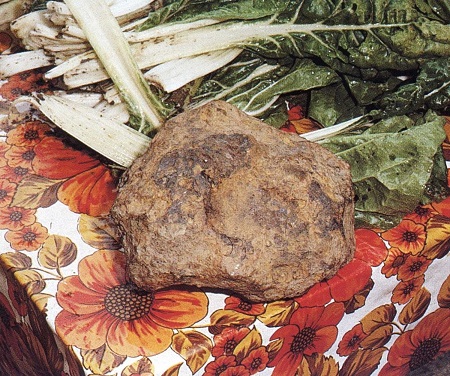
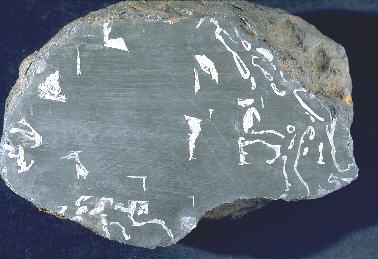
Twannberg—Top: complete stone photographed by Rolf Buehler; Bottom: sectioned main mass
click on the bottom photo for an enlarged view
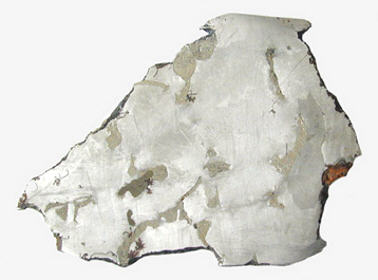
La Primitiva—a 74.2 g full slice of this IIG iron
Photo courtesy of Sergey Vasiliev—
SV-meteorites











